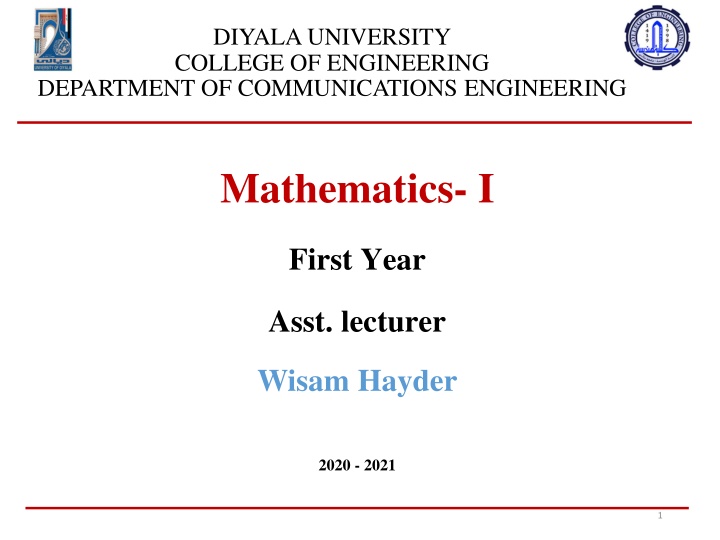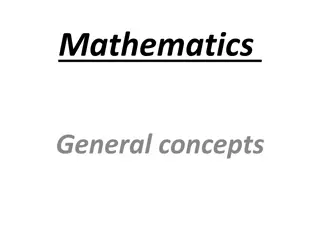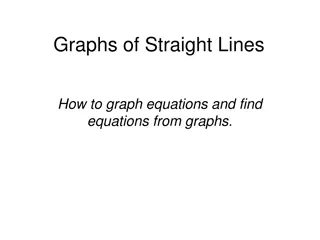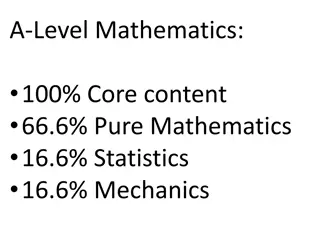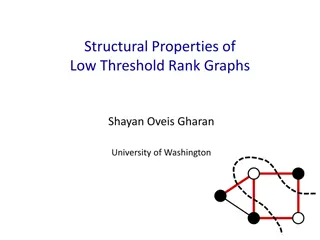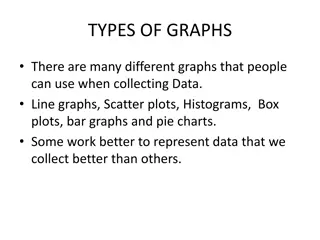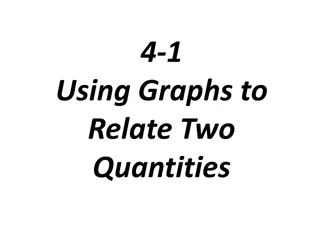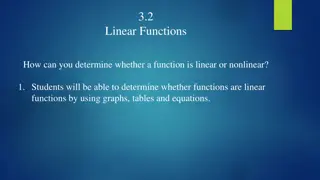Functions and Their Graphs in Mathematics
Functions in mathematics play a crucial role in understanding relationships between variables. This content dives into the concepts of functions, domains, ranges, and how to graph them effectively. It also explores examples to verify natural domains and ranges of functions, along with graphing functions on the Cartesian plane. Understanding functions and their graphs is fundamental for various mathematical applications.
Download Presentation

Please find below an Image/Link to download the presentation.
The content on the website is provided AS IS for your information and personal use only. It may not be sold, licensed, or shared on other websites without obtaining consent from the author.If you encounter any issues during the download, it is possible that the publisher has removed the file from their server.
You are allowed to download the files provided on this website for personal or commercial use, subject to the condition that they are used lawfully. All files are the property of their respective owners.
The content on the website is provided AS IS for your information and personal use only. It may not be sold, licensed, or shared on other websites without obtaining consent from the author.
E N D
Presentation Transcript
DIYALA UNIVERSITY COLLEGE OF ENGINEERING DEPARTMENT OF COMMUNICATIONS ENGINEERING Mathematics- I First Year Asst. lecturer Wisam Hayder 2020 - 2021 1
Functions and Their Graphs Functions; Domain and Range (y equals of x). y = (x) The symbol represents the function, the letter x is the independent variable representing the input value of , and y is the dependent variable or output value of at x. DEFINITION Afunction from a set D to a set Y is a rule that assigns a unique (single) element (x) Y to each element x D. 2
Functions and Their Graphs The set D of all possible input values is called the domain of the function. The set of all values of (x) as x varies throughout D is called the range of the function. The range may not include every element in the set Y. A function is like a machine that produces an output value (x) in its range whenever we feed it an input value x from its domain (Figure 1.) FIGURE 1.Adiagram showing a function as a kind of machine. 3
Functions and Their Graphs Afunction can also be pictured as an arrow diagram (Figure 2). Each arrow associates an element of the domain D with a unique or single element in the set Y. In Figure 2, the arrows indicate that (a) is associated with a, (x) is associated with x, and so on. Notice that a function can have the same value at two different input elements in the domain (as occurs with (a) in Figure 2), but each input element x is assigned a single output value (x). 4
Functions and Their Graphs FIGURE 2.Afunction from a set D to a set Y assigns a unique element of Y to each element in D. EXAMPLE 1 Let s verify the natural domains and associated ranges of some simple functions. 5
Graphs of Functions If is a function with domain D, its graph consists of the points in the Cartesian plane whose coordinates are the input-output pairs for . The graph of the function ? ? = ? + 2 is the set of points with coordinates (x, y) for which y = ? + 2. Its graph is the straight line sketched in Figure 3. FIGURE 3. The graph of ? ? = ? + 2 is the set of points (x, y) for which y has the value x + 2. 6
Graphs of Functions EXAMPLE 2 Graph the function ? = ?2over the interval [ 2, 2]. Solution Make a table of xy- pairs that satisfy the equation ? = ?2. Plot the points (x, y) whose coordinates appear in the table, and draw curve (labeled with its equation) through the plotted points (see Figure 4.). FIGURE 4. Graph of the function in Example 2. 7
Shifting and Scaling Graphs Shifting a Graph of a Function A common way to obtain a new function from an existing one is by adding a constant to each output of the existing function, or to its input variable. The graph of the new function is the graph of the original function shifted vertically or horizontally, as follows. 8
Shifting and Scaling Graphs EXAMPLE 3 (a) Adding 1 to the right-hand side of the formula ? = ?2to get ? = ?2+1 shifts the graph up 1 unit (Figure 5). (b) Adding 2 to the right-hand side of the formula ? = ?2to get ? = ?2 2 shifts the graph down 2 units (Figure 5). (c) Adding 3 to x in ? = ?2to get ? = (? + 3)2shifts the graph 3 units to the left (Figure 6). (d) Adding 2 to x in ? = ? , and then adding 1 to the result, gives ? = ? 2 1 and shifts the graph 2 units to the right and 1 unit down (Figure 7). 9
Shifting and Scaling Graphs FIGURE 5. To shift the graph of ?(?) = ?2up (or down), we add positive (or negative) constants to the formula for (Examples 3a and b). FIGURE 6. To shift the graph of y = ?2 to the left, we add a positive constant to x (Example 3c). To shift the graph to the right, we add a negative constant to x. 10
Shifting and Scaling Graphs FIGURE 7. Shifting the graph of ? = ? 2 units to the right and 1 unit down (Example 3d). Vertical and Horizontal Scaling Formulas 11
Shifting and Scaling Graphs EXAMPLE 4, Here we scale the graph of ? = ?. (a) Vertical: Multiplying the right-hand side of ? = ? by 3 to get ? = 3 ? stretches the graph vertically by a factor of 3, whereas multiplying by 1 3 compresses the graph by a factor of 3, (Figure 8). (b) Horizontal: The graph of ? = 3? is a horizontal compression of the graph of ? = ? by a factor of 3, and ? = ? 3 is a horizontal stretching by a factor of 3 (Figure 9). 12
Shifting and Scaling Graphs Note that ? = 3? = 3 ? so a horizontal compression may correspond to a vertical stretching by a different scaling factor. Likewise, a horizontal stretching may correspond to a vertical compression by a different scaling factor. 13
Shifting and Scaling Graphs FIGURE 8.Vertically stretching and FIGURE 9. Horizontally stretching and Compressing the graph ? = by a ? compressing the graph ? = ? by a factor of factor of 3 (Example 4a). 3 (Example 4b). 14
Trigonometric Functions Angles Angles are measured in degrees or radians. The number of radians in the central angle A'CB' within a circle of radius r is defined as the number of radius units contained in the arc s subtended by that central angle. If we denote this central angle by when measured in radians, this means that = ? ? (Figure 10), or ? = ? ( in radians) (1) FIGURE 10. The radian measure of the central angle A'CB' is the number = ? ?. For a unit circle of radius ? = 1, arc AB that central angleACB cuts from the unit circle. is the length of 15
Trigonometric Functions ? radians = 180 (2) and 1 radian = 180 ? ( 57.3 degrees) or 1 degree = 0.017??????? . ? 180 Table 1.2 shows the equivalence between degree and radian measures for some basic angles. 16
Trigonometric Functions The Six Basic Trigonometric Functions We then define the trigonometric functions in terms of the coordinates of the point P(x, y) where the angle s terminal ray intersects the circle (Figure 12). FIGURE 12. The trigonometric FIGURE 11. Trigonometric ratios of functions of a general angle are an acute angle. defined in terms of x, y, and r. 17
Trigonometric Functions These extended definitions agree with the right-triangle definitions when the angle is acute. Notice also that whenever the quotients are defined, FIGURE 13. Radian angles and side lengths of two common triangles. 18
Exponential Functions Exponential Behavior When a positive quantity P doubles, it increases by a factor of 2 and the quantity becomes 2P. If it doubles again, it becomes 2(2P) = 22? and a third doubling gives 2 22? = 23?. Continuing to double in this fashion leads us to the consideration of the function ? ? = 2?. We call this an exponential function because the variable x appears in the exponent of 2?. Functions such as g ? = 10?and ? = (1 2)?are other examples of exponential functions. In general, if ? 1 is a positive constant, the function ? ? = ?? is the exponential function with base ?. 20
Exponential Functions FIGURE 14. Graphs of exponential functions. 22
Exponential Functions EXAMPLE 5 We illustrate using the rules for exponents. 23
Exponential Functions The Natural Exponential Function ?? The most important exponential function used for modeling natural, physical, and economic phenomena is the natural exponential function, whose base is the special number e. The number e is irrational, and its value is 2.718281828 to nine decimal places. 24
Inverse Functions and Logarithms Inverse Functions The process of passing from to ? 1can be summarized as a two-step procedure. 25
Inverse Functions and Logarithms EXAMPLE 6 Find the inverse of ? =1 function of x. 2? + 1 expressed as a FIGURE 1.62 Graphing ? ? = ? 1? = 2? 2 symmetry with respect to the line y = x (Example 6). 1 2 x + 1 and together shows the graphs
Inverse Functions and Logarithms Logarithmic Functions DEFINITION of the base ? exponential function ? = ??(? > 0,? 1). The logarithm function with base a, ? = ????x , is the inverse 27
Inverse Functions and Logarithms Properties of Logarithms 28
Inverse Functions and Logarithms EXAMPLE 6 Here are examples of the properties in Theorem 1. 29
